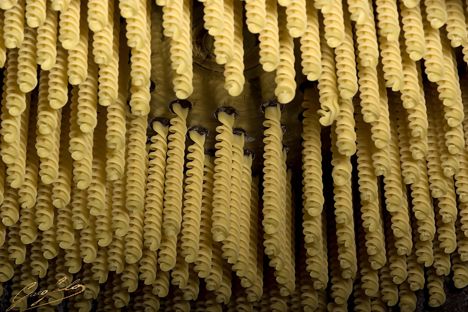
Garofalo: the art of making quality pasta
Garofalo has been making pasta in the legendary town of Gragnano in Campania since 1789, making them one of Italy’s oldest brands. We find out more about the town’s long-held traditions and the production process behind Garofalo’s top-quality pasta.
Garofalo: the art of making quality pasta
Garofalo has been making pasta in the legendary town of Gragnano in Campania since 1789, making them one of Italy’s oldest brands. We find out more about the town’s long-held traditions and the production process behind Garofalo’s top-quality pasta.
Found in kitchens up and down the country, both at home and in restaurants, there are few ingredients more ubiquitous than pasta. Whether it’s twirls of fusilli, nests of tagliatelle or strands of spaghetti, chances are that most people will always have some form of pasta at the ready. Yet as it’s thrown into a pan of boiling water for cooking, few of us will actually stop to think about the work that has already gone into creating these perfectly-formed shapes. Garofalo is one of Italy’s oldest brands, having produced high-quality pasta for over 200 years in Gragnano, the town known to be the spiritual home of pasta. Today, Garofalo is one of the leading manufacturers of quality pasta in Italy, with many of its shapes having the guaranteed quality seal of ‘Pasta di Gragnano PGI’, and that’s thanks to its meticulous production process and commitment to excellence.
Tucked between the Amalfi Coast and the slopes of the Lattari Mountains, the Italian hill-top town of Gragnano has a five-century-long history of pasta making, which has over time seen it become the epicentre of Italy’s dried pasta industry. This isn’t a coincidence, it’s down to Gragnano’s favourable climate and location in the Gulf of Naples, meaning that the town benefits from a coastal breeze balanced with humidity – perfect for drying pasta. The local spring water meanwhile, which is used in the production process, is low in chlorine, giving Gragnano pasta its unique characteristics.
As a recognition of the exceptional quality of pasta coming out of the town, Pasta di Gragnano was awarded PGI status in 2013, ensuring that a strict criteria is followed when making the pasta. These include the recipe, which must only consist of durum wheat semolina and water, the requirement for the dough to be extruded through a bronze die, and an all-important slow drying process. In 2003, the Gragnano Città della Pasta Consortium was established to protect Pasta di Gragnano both in Italy and also across the world, becoming the official protection consortium for the PGI pasta in 2019. Today, the consortium is comprised of sixteen producers – of which Garofalo is the largest – who together protect the artistry behind Gragnano’s pasta. This is the reason why the PGI mark appears on many of Garofalo’s packs.
Beyond the rules and regulations stated by the PGI, what is it though, that makes Garofalo’s pasta so consistently excellent? It begins with the ingredients used to make the dough. Garofalo has the final product in mind from the start of the production process. This means only first-class semolina is used that has been produced using durum wheat chosen for its flavour profile, gluten level and colour. The gluten level and quality (or index) is probably the most important of these features, as it dictates the firmness of the pasta and its cooked texture during eating. By prioritising durum wheat semolina with a high gluten index, Garofalo ensures its pasta maintains its shape once cooked. The semolina is then mixed with local spring water at a low enough temperature that the natural colour of the grain is preserved in the dough.
Perhaps the most distinct feature of the majority of Garofalo’s shapes (and all Gragnano PGI pasta) though, is the fact it’s made using bronze dies, giving the final product both a rough, porous finish – which helps the sauce cling to the pasta – and a better colour balance. The dough is drawn through these bronze plates and emerges with small abrasions, which teflon-drawn pastas lack. There is still a place for teflon dies however, in particular when creating shapes of pasta like capellini which need to keep their shape when submerged in a broth or soup. Once it’s been extruded, the only remaining step for Garofalo is to dry the pasta, which is done at varying temperatures of between forty and eighty degrees to carefully manage the pace at which the water is removed from the dough, resulting in less breakages of the final product.
It may seem like a meticulous process, but it’s one which Garofalo has proved over the years results in pasta of unquestionable quality and is why Garofalo products are now exported to over sixty countries in the world. One of the most distinct features of Garofalo pasta, along with its porosity, is its firm texture which is maintained to some extent even when it’s cooked for longer than suggested on the pack. Even the optimal cooking time for Garofalo pasta has been scrupulously tested using a mechanical tooth so that people can easily achieve the perfect al dente finish without undercooking it.
There’s a misconception that the craft of creating exceptional pasta always involves making it fresh but the quality of Garofalo proves that there’s just as much skill to producing dried pasta, like they do in Gragnano; we just know far less about the work that goes into it. However, with the Gragnano PGI now in place and brands like Garofalo continuing to guarantee only the finest quality of product, the art of making exceptional dried pasta is in safe hands.

